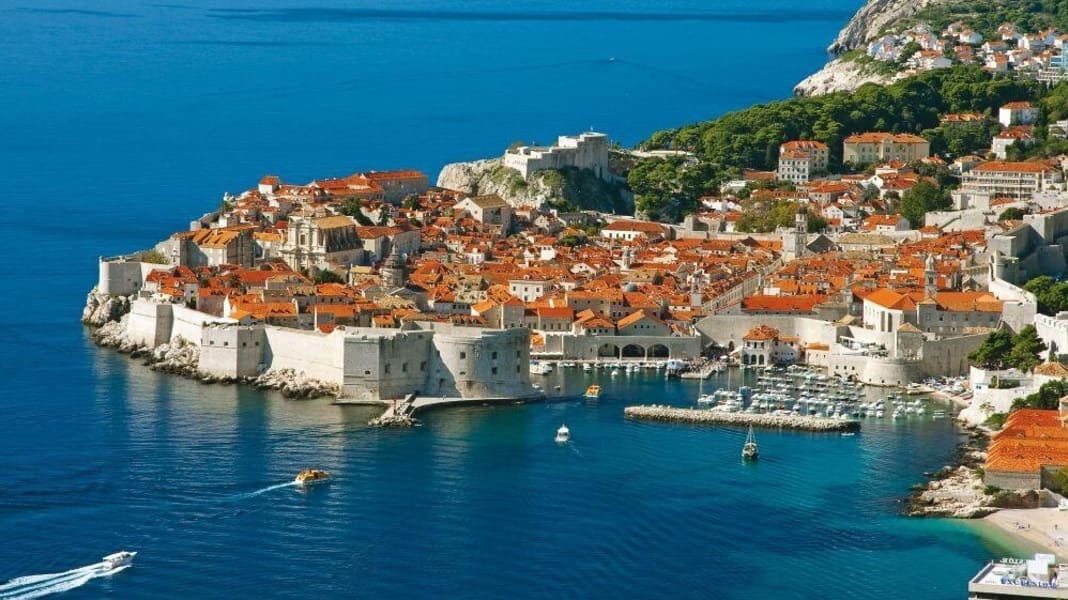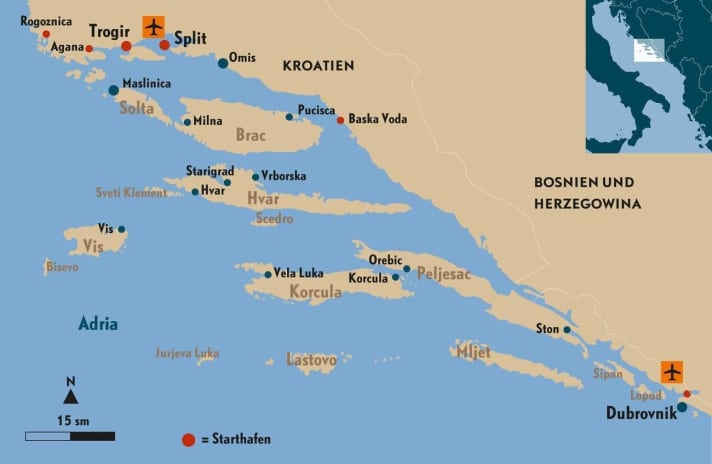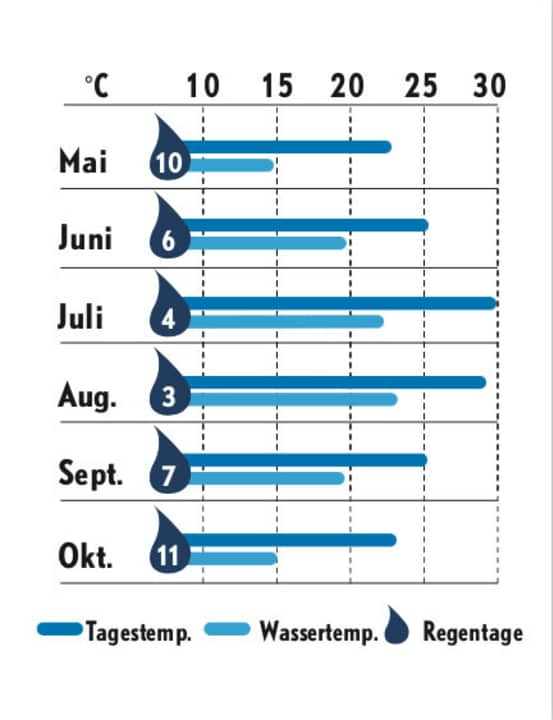
ARRIVAL

Most crews arrive via the airports of Split or Dubrovnik, which are easy to reach by plane from Germany. Transfers to the charter bases usually only take 20 or 30 minutes, mostly from Split to Kastela or Dubrovnik to the ACI marina. By car, it is almost 900 kilometres from Munich to the south of the region, for example to Kastela near Split. Accordingly, few people will consider the Flixbus as an alternative, which runs directly from Munich but takes almost 15 hours.






CHARTER
The most frequently used starting harbour is Split, where Marina Kastela is the largest charter departure harbour on the entire coast. However, there are also other bases in the surrounding area, for example in Trogir, Agana or Rogoznica. If you want to start further south, choose Dubrovnik. There are a few other bases on the mainland, for example in Baska Voda, but these are rather unfavourable due to the longer transfers. However, the area is so popular that many crews who want to sail here no longer get any boats in the high season and then start from bases further north near Sibenik or Murter. The choice of fleets is huge, which means comparatively low prices in Europe, even if the south is currently in high demand.

WIND & WEATHER
In the summer months, the Maistral, a lighter wind from the north-west, blows very frequently on the coast. It develops gradually throughout the morning and usually reaches 3 to 4 Beaufort in the afternoon. It dies down again relatively quickly towards the evening.
Strong winds and storms can be caused by the bora from the north-east, which can be particularly violent in the early and late season, but is also always good for surprises in summer. Crews should seek shelter in good time if bora is forecast. It often blows in very clear, good weather. If in doubt, consult Croatian sources if the forecast is critical.
From the south blows the so-calledJugowhich almost always means a deterioration in the weather withClouds and rain brings with it. It can also reach gale force, but is generally not as gusty as the bora. It is rare in summer and often alternates with the bora in the early and late season. Prolonged jugo bringshigh swellas it has a long approach route across the Adriatic.
The Croatian weather service predicts bora and jugo quite reliably. Otherwise, the usual online or app weather information sites such as Windy.com , Windfinder.com (Pro version!) and others.
NAVIGATION & SEAFARING
The south is relatively easy to navigate, there are slightly fewer shallows and tiny islets and piles of stones than in the centre of the country. The greater distances between the offshore islands mean less protection than in the north, but the bora generally blows a little weaker here.
There are a large number of buoy fields in the area, which the state allocates to leaseholders and of which there are now around 70 to 80 throughout the country. Anyone using the buoys must pay; prices vary from around 2 to 5 euros per boat metre, depending on the location and popularity of the field. Important: If you want to anchor, you must keep at least 150 metres away from the fields (previously 250 metres). There are occasional disputes about this regulation: Some operators also try to charge crews who anchor close to the fields. In such cases, you should keep a generous distance to avoid trouble.
Not all buoy ground tackle is strong enough and well maintained. In Croatia, the operators are not liable for the condition of the buoys, so you should not blindly rely on them in bad weather.
Important in Croatia: The charter crew of the boat must have a radio licence holder (SRC) on board, according to the regulations. It does not necessarily have to be the skipper, but it happens from time to time that a charter company requires this. And: If a dinghy is operated with an outboard motor, a person with a licence must be on board, regardless of how much horsepower it has.
HARBOURS & ANCHORAGES
The south of Croatia has a somewhat less dense chain of genuine full-service marinas than the centre and north, so the harbours of Korcula, Dubrovnik and Split are often packed, especially at weekends. If you want to be sure of a place there, you have to arrive early or book in advance. You can do this via the ACI marina association website or via harbour portals such as My Sea. However, the many pretty municipal harbours and private piers belonging to restaurants or konobas are a good alternative to expensive marinas. Mooring fees vary accordingly. The prices for berths are high in the popular marinas; for a twelve-metre boat in Korcula, Dubrovnik or Split, for example, you will pay around 70 to 100 euros during the season, while municipal ports or smaller marinas are significantly lower. Please note that some ACI marinas are more expensive at weekends than during the week.
The coasts of the islands offer a variety of beautiful and well-protected anchorages.
LITERATURE
Karl-Heinz Beständig, "Croatia - 808 harbours and bays", self-published (Karl-Heinz.Beständig@t-online.de). "Küstenhandbuch Kroatien, Montenegro", Edition Maritim, 29.90 euros.
Nautical charts: Sport boat charts set 7: Adriatic 2, Delius Klasing, 59.90, NV Verlag Croatia 1 and 2, 49 euros each, both incl. app use. Croatian pleasure craft charts: Adriatic Set South, 69.90 euros.
TERRITORY CHARACTERISTICS
The south of Croatia is currently the most popular spot on the Adriatic and probably in the entire Mediterranean. The coast there is somewhat different from the centre: The offshore islands such as Brac, Hvar or Korcula are larger than most of those further north. They often rise higher, are more mountainous and there is more greenery. All in all, this makes for a picturesque backdrop, especially as many island towns blend in beautifully: Korcula, Dubrovnik, Hvar - all destinations that are definitely worth visiting. Crews will find great old towns with winding alleyways, palm-lined promenades and a wide range of shops and restaurants to suit every taste and budget.
The ideal complement to this is a huge selection of beautiful anchor bays with crystal-clear water around the coasts of the islands, which offer beautiful spots en masse. You need them too, because the area gets crowded in high summer.
In many bays, one or more restaurant operators are waiting for crews and often have good jetties, even with mooring lines, sanitary facilities, electricity and beautiful terraces. Sailors love the area for these small jetties and places, which are sometimes used almost exclusively by yacht crews. Just like in more northerly Croatia, there are buoy fields in some bays that are subject to a fee, which on the one hand restrict free anchoring, but on the other hand are appreciated by many crews as an anchoring alternative.
The distances between the islands are somewhat greater in southern Dalmatia and therefore offer less protection than the more northerly coast in some sections, for example when crossing to the outlying islands of Vis or Lastovo. Nevertheless, the area is not much more challenging than the centre, where there are significantly more shallows, for example. Shoals are usually well buoyed, current is rarely a problem, crews are most likely to have to deal with a strong bora. If you like, you can simply move from one destination to the next along the long coasts of the large islands. The distances are then short and more than a few hours of sailing are never really necessary.
The area around Split is very busy in high summer due to the massing of the fleet there. If you want to avoid the hustle and bustle, you can sail further south. From about Korcula onwards, it gets a little emptier. This is especially true for crews who are travelling for a fortnight. Otherwise, the area is also ideal for a week's sailing. Starting from Split, a round trip of around 80 to 100 miles via Solta, the west side of Brac, Korcula or Vis is ideal. Here you will find a very varied area with so many alternative stops that even a second or even third trip will not be boring.

